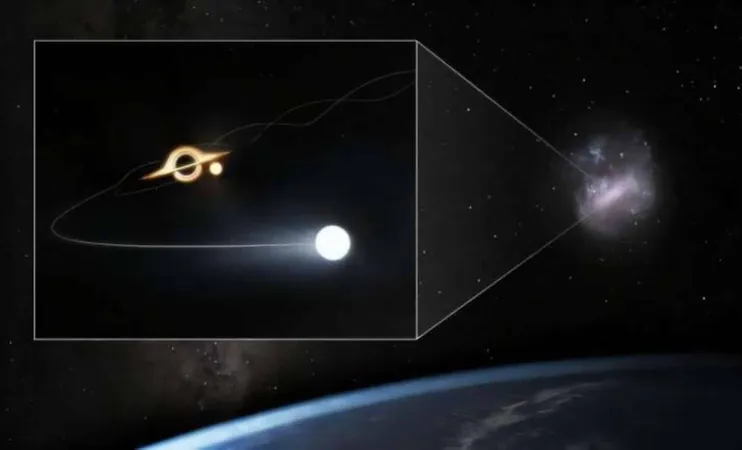
Astronomers Unveil Shocking Discovery: A Hidden Supermassive Black Hole Just Next Door!
2025-03-10
Author: Kai
Astronomers Make an Astonishing Discovery
Astronomers have made an astonishing discovery: a previously unknown supermassive black hole lurking in the Large Magellanic Cloud (LMC), one of the Milky Way's closest galactic neighbors. This groundbreaking finding was accomplished using data from the European Space Agency's Gaia mission and reveals the existence of a black hole weighing in at 600,000 times the mass of our Sun. Shockingly, this black hole has been ejecting stars into intergalactic space at speeds reaching millions of miles per hour!
This thrilling revelation presented by researchers in a newly published study on arXiv highlights not only the complexity of runaway stars but also the stealthy nature of black holes. These enigmatic cosmic entities are notorious for giving off no light, making them exceedingly hard to detect. However, this specific black hole came to light due to the violent ejection of hypervelocity stars - stars that are traveling too fast to ever return to the Milky Way.
Researchers from the Harvard-Smithsonian Center for Astrophysics argue that while half of these runaway stars can trace their origins to our own galaxy's central black hole, Sagittarius A*, the other half has intriguingly stemmed from the LMC, leading to unexpected revelations about cosmic dynamics.
Forensic Astronomers at Work
Astronomers employ techniques akin to forensic analysis to track the trajectories of these hypervelocity stars, drawing conclusions about their sources. By studying 21 of these incredibly fast-moving stars at the fringes of our galaxy, they made an unexpected connection to the LMC, a region once believed to lack any supermassive black hole.
Lead author of the study, Jesse Han, expressed excitement over the find: “It is astounding to realize that we have another supermassive black hole just down the block, cosmically speaking. Black holes are so stealthy that this one has been practically under our noses this whole time.
The speeds observed in these runaway stars are staggering - some exceed a million miles per hour, far too rapid for the Milky Way to have propelled them all. By simulating the orbits of the stars, researchers traced many back to the LMC, where they had unearthed a hidden black hole.
How Black Holes Create Cosmic Fireworks
The dramatic process that leads to the production of hypervelocity stars is linked to a fascinating phenomenon involving binary star systems—pairs of stars orbiting one another. When such a system ventures too close to a supermassive black hole, the intense gravitational forces can tear the pair apart. One star becomes entrapped in orbit around the black hole, while the other is flung away into space at staggering velocities.
Co-author Kareem El-Badry explained this explosive behavior: “Hypervelocity stars are created when a double-star system ventures too close to a supermassive black hole. The intense gravitational pull from the black hole rips the two stars apart, capturing one and flinging the other out of the galaxy.”
Although scientists had long speculated about the existence of a black hole within the LMC, concrete proof had eluded researchers until now. The team focused their theoretical models on how a black hole in the LMC could generate a unique pattern of hypervelocity stars, and the new observational data aligned perfectly with their predictions.
A Galactic Giant Awaits
While the newfound black hole in the LMC is smaller than Sagittarius A*—which holds approximately 4 million solar masses—it still qualifies as a supermassive black hole and is an exceptionally rare discovery outside of larger galaxies. Compared to stellar-mass black holes, its 600,000 solar masses are impressive, although it pales in comparison to the colossal billion-solar-mass black holes found in some distant galaxies.
Co-author Scott Lucchini stated, “The only explanation we can come up with for this data is the existence of a monster black hole in our galaxy next door.”
This revelation not only confirms the presence of a supermassive black hole in the LMC but also enriches our understanding of the dynamic interplay between galaxies. As the LMC hurtles toward the Milky Way on a collision course, it is anticipated that, in billions of years, this merger will funnel new material into our own central black hole, heralding a new era of cosmic evolution.
Stay tuned as scientists continue to unravel the mysteries of the universe; who knows what other hidden wonders still await discovery!





 Brasil (PT)
Brasil (PT)
 Canada (EN)
Canada (EN)
 Chile (ES)
Chile (ES)
 Česko (CS)
Česko (CS)
 대한민국 (KO)
대한민국 (KO)
 España (ES)
España (ES)
 France (FR)
France (FR)
 Hong Kong (EN)
Hong Kong (EN)
 Italia (IT)
Italia (IT)
 日本 (JA)
日本 (JA)
 Magyarország (HU)
Magyarország (HU)
 Norge (NO)
Norge (NO)
 Polska (PL)
Polska (PL)
 Schweiz (DE)
Schweiz (DE)
 Singapore (EN)
Singapore (EN)
 Sverige (SV)
Sverige (SV)
 Suomi (FI)
Suomi (FI)
 Türkiye (TR)
Türkiye (TR)
 الإمارات العربية المتحدة (AR)
الإمارات العربية المتحدة (AR)